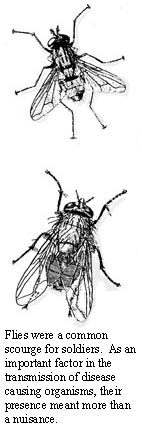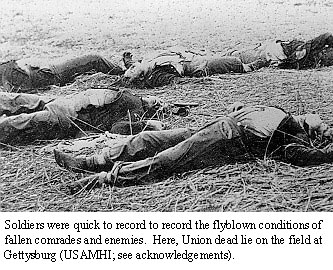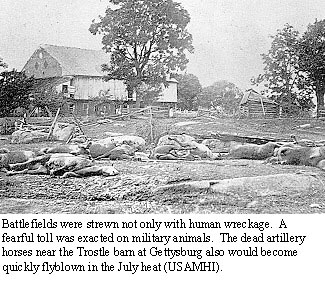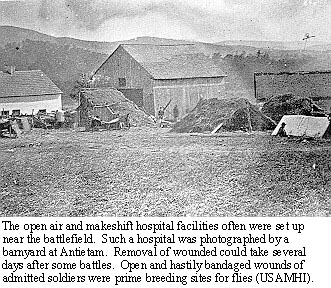Historical Natural History: Insects and the Civil War
Gary L. Miller
This article is reprinted and adapted in part from Miller, G. L. 1997. Historical Natural History: Insects and the Civil War. American Entomologist 43:227-245.
Portions of this article are copyrighted by the Entomological Society of America and are reprinted with permission. Other reproduction of this material is prohibited.
Section 2: Flies by the Scores
At the call to arms, communities throughout the North and South began assembling troops. It was evident that insects also were amassing with the soldiers. Flies were advance denizens of those bivouacs. Flies are an important group of insects medically because of the role they play in disease transmission. House flies, blow flies, and bottle flies are all examples of some non-biting flies that can be extremely problematic and probably confronted the soldiers throughout the war.

Early in the war, one Confederate described the fly problem in camp:
When we open our eyes in the morning we find the canvas roofs and walls of our tents black with them [flies] . . . It needs no morning reveille then to rouse the soldier from his slumbers. The tickling sensations about the ears, eyes, mouth, nose, etc., caused by the microscopic feet and inquisitive suckers of an army numerous as the sands of the sea shore will awaken a regiment of men from innocent sleep to wide-awake profanity more promptly than the near beat of the alarming drum. (Wiley 1994)
Another Confederate continued, "I get vexed at them and commence killing them, but as I believe forty come to every one's funeral I have given it up as a bad job" (Wiley 1994). Avoiding the enemy proved easier than avoiding flies.
To appreciate the fly problems that confronted the soldiers, it is important to understand soldiering in the Union and Confederate armies. This was an era before the highly mechanized armies of the twentieth century. Excepting river transport, trains, and one's own feet, much of the transportation depended upon animals- - -horses, mules, and, occasionally, oxen. The number of animals required to support both armies dwarfs anything by today's standards. In 1864, the Army of the Potomac was followed by more than 4,000 six-mule team wagons as it entered the Wilderness Campaign (5). The total number of horses and mules that began that campaign was 56,499. Armies from the western theater also maintained a large animal entourage. General Sherman's army of 60,000 was accompanied by 2,500 wagons and 600 ambulances (Billings 1887). It is probable that those wagons also were pulled by six-mule teams.
This, too, was an era before modern MREs (Meals Ready to Eat). Meat rations commonly were supplied as fresh beef, although this was often a luxury for many Confederate soldiers. To supply meat for the soldiers, large cattle trains had to be moved with the army. When the Union army crossed the Rapidan before the Wilderness Campaign, it was accompanied by an estimated 8- -10,000 head of cattle (Billings 1887). This massing of humanity and animals produced equally large quantities of garbage, refuse, and excrement that surrounded the soldiers from all sides. A Virginia private elaborated in his diary: "Dec. 3, 1863 . . . On rolling up my bed this morning I found I had been lying in - I wont say what - something though that didn't smell like milk and peaches" (Wiley 1994).
At the beginning of a new campaign, marching routes usually were strewn with every imaginable article of clothing and personal effect deemed unnecessary or too burdensome by the soldier. But widespread untidiness probably best manifested itself in camp. Brooks' (1966) description of the soldiers' camps was no doubt apt.
Few recruits bothered to use the slit-trench latrines (and those who did usually forgot to shovel dirt over the feces) and most urinated just outside the tent--and after sundown, in the street. Garbage was everywhere, rats abounded, and dead cats and dogs turned up in the strangest places. The emanations of slaughtered cattle and kitchen offal together with the noxious effluvia from the seething latrines and infested tents produced an olfactory sensation which has yet to be duplicated in the Western Hemisphere. As for water--and seldom was there enough--any source would do in the early camps. Frequently, it was so muddy and fetid the men held their noses when they drank the stuff. In many instances, the heavy rains washed fecal material directly into the supply with disastrous consequences.
The extensive untidiness made excellent breeding habitats for filth flies, especially during the warmer months. The flies' presence represented more than just a nuisance. The habit of crawling on refuse and excrement and then on humans and their food was a serious problem, one not fully realized at the time. Flies are potential vectors of pathogens that cause cholera, diarrhea, dysentery, and typhoid (Greenberg 1973). By the end of the war, diseases would take the lives of more soldiers than would hostile fire (Brooks 1966).
Dysentery and diarrhea were by far the most common ailments in both Union and Confederate armies. Although flies probably were not involved in every enteric disease, there is little doubt they contributed to the prominence of such ailments. Whether soldiers called it the "quickstep" or the "alvine flux," diarrhea and dysentery were the Civil War's greatest cause of misery. Union records list more than 1.7 million cases of dysentery and diarrhea, maladies that took the lives of nearly 60,000 soldiers (Wiley 1992). The suffering from these diseases was especially bad in prisons. More than 4,500 of nearly 20,000 Union prisoners confined between 1 March and 31 August 1864, died of dysentery and diarrhea at Andersonville, GA (Brooks 1966). Confederate prisoners also suffered; of the nearly 41,000 Rebels held at various prisons in the North, dysentery and diarrhea took 6,000 lives (Brooks 1966).
Symptoms of dysentery and diarrhea manifested themselves as more than an occasional case of loose bowels; one soldier noted that his bowels moved 18 times in three hours while he was on as Corporal of the Guard (Wiley 1992). Rank would not exempt one from ravages of the flux. At the battle of Gettysburg (6), General Robert E. Lee suffered with severe diarrhea (Freeman 1935), prompting some students of the Civil War to wonder if his debilitation played some role in the Confederates' defeat. With such problems, it is amazing that either the Union or Confederate army could carry out its duties, especially when called to battle. One Confederate elaborated on a cure for the bowel problems that plagued him:
I with a number of others were sufferers from camp diarrhea, as it was called, and up to that time we had found no cure--so, entering the battle, I had quite a great fear that something disgraceful might happen and it was somewhat uppermost in my mind; but to my surprise the excitement or something else, had effected a cure. I inquired of some of the others and they reported a cure. (Wiley 1994)
Because this "battlefield" cure was not constantly available or especially welcomed, other medicaments were sought. Treatments of opium and belladonna were therapeutic in checking diarrhea. Yet, other commonly prescribed treatments-- eavy drafts of whiskey, doses of salts, calomel, turpentine, castor oil, chalk, and blue pills of mercury--led to disastrous results by aggravating the condition. Constipation was indeed a luxury for either Yank or Reb!

Fly problems were bad enough during periods of noncombat, but they were even worse after battle and added to the horrors of war. Although modern warfare has provided mechanized equipment to dig mass graves, produced various residual chemical sprays to inhibit fly development, and even supplied large quantities of petroleum fuels for burning the corpses, such technology was not present or utilized during the Civil War. Bodies often were buried hastily or, in many cases, never buried. The carnage of the battlefield made a prime breeding and feeding ground for flies, but humans were not the only casualties of these battles. Fearful tolls also were exacted on the military animals; at the Battle of Gettysburg, more than 1,500 artillery horses were killed. One Confederate Colonel recounted a scene at Cold Harbor. "The stench from the dead between our line and theirs was ... so nauseating that it was almost unendurable; but we had the advantage, as the wind carried it away from us to them. The dead covered more than five acres of ground about as thickly as they could be laid." (Ward 1992). Scenes of the fallen repeated themselves throughout the conflict. Although this fetor was repulsive to the soldiers living near the battle scenes, byproducts of the dead, such as putrescine and cadaverine, are attractive for the flies.
One Rebel private described the human wreckage after the Battle of the Angle (7) at Spottsylvania, VA:
"Those who were not very badly mutilated were swollen as long as they could swell. Their faces were nearly black, and their mouths, nose, eyes, hair, and the mutilated parts were full of maggots! This is a horrible picture, but ... it is not overdrawn. What an awful scent!" (Wheeler 1991).
That much of the active campaigning took place during warmer months provided optimal breeding temperatures for flies, and the dead bodies quickly became maggot infested. One Pennsylvania private at the Battle of Antietam (8) recalled after the war,
"In the burial of the dead on this particular part of the field, the 130th Regiment, by reason of having incurred the displeasure of its brigade commander, was honored in the appointment as undertaker-in-chief. The weather was phenomenally hot, and the stench from the hundreds of black bloated, decomposed maggoty bodies, exposed to a torrid heat for three days after the battle, was a sight truly horrid and beggaring all power of verbal expression"(Stotelmyer 1992).

As the bodies of the dead quickly became infested, the battle wounds of the living also became flyblown. Maimed and wounded soldiers sometimes remained for days on the battlefield before receiving attention or being moved to a hospital. The exposed and open wounds also became prime breeding and feeding sites for carnivorous species of flies. Sallie Broadhead (1864), a civilian who kept a diary during the Battle of Gettysburg, recorded the following incident just a few days after the battle.
I assisted in feeding some of the severely wounded, when I perceived that they were suffering on account of not having their wounds dressed. I did not know whether I could render any assistance in that way, but I thought I would try. I procured a basin and water, and went to a room where there were seven or eight, some shot in the arms, others in the legs, and one in his back, and another in the shoulder. I asked if any one would like to have his wounds dressed? Some one replied, "There is a man on the floor who cannot help himself, you would better see to him." Stooping over him, I asked for his wound, and he pointed to his leg. Such a horrible sight I had never seen and hope never to see again. His leg was all covered with worms [maggots].
If an exposed wound was not infested on the field, there was a good chance it would become so at the hospital. One Union private described a hospital scene: "Near the hospital was a pile of arms, legs, hands, and feet that had been cut from the wounded. These had not been buried, just thrown in a pile and worms [maggots] had begun to work on them" (Strong 1961). Union surgeons got rid of maggots in wounds with chloroform. Because of shortages in medical supplies, Confederate doctors did not always have access to such supplies. They discovered accidentally that the maggots were actually more efficient at digesting necrotic tissue than a scalpel or nitric acid (Brooks 1966). J. F. Zacharias, a surgeon in the Confederate army wrote:
During my service in the hospital at Danville, Virginia, I first used maggots to remove the decayed tissue in hospital gangrene and with eminent satisfaction. In a single day, they would clean a wound much better than any agents we had at our command. I used them afterwards at various places. I am sure I saved many lives by their use, escaped septicemia, and had rapid recoveries (Greenberg 1973).
Besides their efficiency, the maggots also excrete allantoin, which aids in the digestion of necrotic tissue and, thus, promotes new tissue growth. However, maggot therapy works best under sterile conditions--a situation that was a rarity during the Civil War given the lack of understanding of germs. Maggot therapy was not novel to the Civil War and had been rediscovered various times throughout history (Brooks 1966).

Prime breeding sites for flies existed around the camps, battlefields, and hospitals, but conditions also were ripe in the squalor of the prison camps. Probably the most notorious of these camps was the one at Andersonville, GA. Here, of the 33,000 Union prisoners confined on 26 stockaded acres, over 13,000 died; in the summer of 1864, the death rate was well over 100 per day (Byrne 1983). A visiting Confederate physician recorded some of the conditions at the prison. Near one area for cooking was a mound of "corn bread, bones, and filth of all kinds, thirty feet in diameter and several feet in height, swarming with myriads of flies" (Futch 1968). Whereas adult flies filled the air, maggots were found everywhere else. One prisoner recorded,
"us Boys got a spade & took off the top of the ground & it was alive with maggots where we Lay & the Boys say the ground is so all around here Hard but cant be helped there isn't a Hog stye in the North aney nastier than this camp"(Futch 1968).
Prisoners' rations also were likely to be flyblown. One Union diarist recorded beef rations as "some of the wormiest types I ever did see" (Futch 1968). Others concurred: "We draw this evening spoilt beef and maggotly mush alive with worms" and
"Rather Dul fourth I tell you shet up in A hog pen Drew fresh Beef or said to be fresh But I called it rather Oald all Magotts and stunk enough to knock a man over" (Futch 1968).
Maggots even were found in the water supply. The small stream that served for drinking water and a latrine was described as a "semiliquid mass of filth" that contained "innumerable long-tailed large white maggots [rattailed maggots?]" along with "fermenting excrement, and fragments of bread and meat" (Futch 1968). This is an interesting comment for a couple of reasons. First, because rattailed maggots (Syrphidae) live in highly polluted water, it reflects the contaminated condition of that stream. Second, because rattailed maggots sometimes are responsible for human intestinal pseudomyiasis, one wonders if some of the soldiers may have suffered from this condition. Speculation aside, there is little doubt that flies added to the living hell of Andersonville.
Next Section: Gallinippers Galore
- May 5-6, 1864.
- July 1-3, 1863.
- May 12-13, 1864.
- September 17, 1862.
